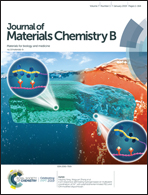A pH-responsive self-healing hydrogel based on multivalent coordination of Ni2+ with polyhistidine-terminated PEG and IDA-modified oligochitosan†
Abstract
Metal coordination hydrogels have drawn intensive attention in controlled drug release due to their facile incorporation of stimuli and dynamic self-healing properties. However, many metal coordination hydrogels which are responsive to mild physiologically relevant stimuli are restricted by their poor stability in non-triggering environments. Here, we reported a new strategy for enhancing the neutral stability of a pH-responsive self-healing hydrogel based on multivalent metal coordination without loss of its responsiveness. The hydrogel was formed by multivalent coordination of Ni2+ with polyhistidine (PHis) and multiple iminodiacetic acid (IDA) ligands which were modified on the terminal groups of polyethylene glycol (PEG) and the side groups of oligochitosan (OChi), respectively. By incorporating multivalent coordination, the hydrogel maintains its self-healing character and weak acid responsiveness; it can also be used as an injectable hydrogel by injecting it into a neutral environment. Through varying the PHis : IDA ratio, the mechanical strength and dynamic relaxation of the hydrogel can be regulated conveniently. More importantly, the hydrogels with multivalent coordination can remain stable and integral in neutral buffer (pH 7.4); meanwhile, they dissolve quickly in a weak acid environment (pH 5.5), which is similar to some tissue disease conditions. In contrast, the control hydrogel without multivalent coordination disintegrated within 4 hours in the neutral non-triggering buffer. Because the hydrogel consists of large amounts of coordinative Ni2+ ions, it naturally possesses relatively high affinity to molecules containing polyhistidine motifs. Thus, pH-tuned controlled release of a model molecule, rhodamine-modified polyhistidine, was accomplished, with limited neutral leakage and quick release in weak acid. These results indicate potential applications for this multivalent coordination hydrogel in the controlled release field.



 Please wait while we load your content...
Please wait while we load your content...